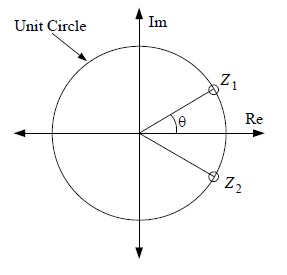| Line 1: | Line 1: | ||
[[Category:2010 Fall ECE 438 Boutin]] | [[Category:2010 Fall ECE 438 Boutin]] | ||
| − | + | [[Category:Problem_solving]] | |
| + | [[Category:ECE438]] | ||
| + | [[Category:digital signal processing]] | ||
---- | ---- | ||
== Quiz Questions Pool for Week 9 == | == Quiz Questions Pool for Week 9 == | ||
Latest revision as of 09:42, 11 November 2011
Quiz Questions Pool for Week 9
Q1. Consider the following second order FIR filter with the two zeros on the unit circle as shown below.
The transfer function for this filter is given by $ H(z) = (1-e^{j\theta}z^{-1})(1-e^{-j\theta}z^{-1})=1-2\cos\theta z^{-1}+z^{-2} $
- a. Find the difference equation of this filter.
- b. Find the frequency response $ H(w) $ from the difference equation by the following two approaches:
- i. apply the input $ e^{jwn} $ to the difference equation describing the system,
- ii. find the DTFT of the impulse response,
- and verify that both methods lead to the same result.
- c. Find the response of this system to the input
- $ x[n]=\left\{ \begin{array}{rl} 1, & \text{ if }n=-1,\\ 1, & \text{ if }n=0,\\ 0, & \text{ else. } \end{array} \right. $
- d. When $ \theta=\pi/2 $, is this filter a lowpass, highpass, bandpass or a bandstop filter?
- e. An interference signal modulated at 2kHz and sampled at 8kHz is being inputted to this system and you want to eliminate this interference. What must be the value of $ \theta $ to eliminate this signal?
Q2. When we have a LTI system, the impulse response $ h[n] $ must be real
in order for $ y[n] $ to be real whenever $ x[n] $ is real.
The condition for $ h[n] $ to be real is
$ h[n]=h^{\ast}[n] $
Then, what is the condition of the frequency response $ H(w) $ for $ h[n] $ to be real?
(Hint: Apply DTFT to the above equation)
Q3.
Consider a DT LTI system described by the following equation
$ y[n] = x[n] + 2x[n - 1] + 0.5y[n - 1] $
a. Compute the impulse response h[n] of the system.
b. Compute the output when x[n] = u[n].
c. Compute the output when $ x[n] = 0.25^nu[n] $.
Q4.
Given the difference equation of the system:
$ y[n]=\frac{1}{M_1+M_2+1}\sum_{k=-M_1}^{M_2}x[n-k]\text{ ,}M_1,M_2\ge 0 $
a. Compute the impulse response of the system h[n]
b. Compute the frequency response of $ H(e^{jw}) $.
c. Suppose $ M_1=0,M_2=4 $. Sketch the magnitude of $ H(e^{jw}) $ on the interval $ [-\pi ,\pi] $
Q5.
Obtain the Duality Property of DFT.
Back to ECE 438 Fall 2010 Lab Wiki Page
Back to ECE 438 Fall 2010


